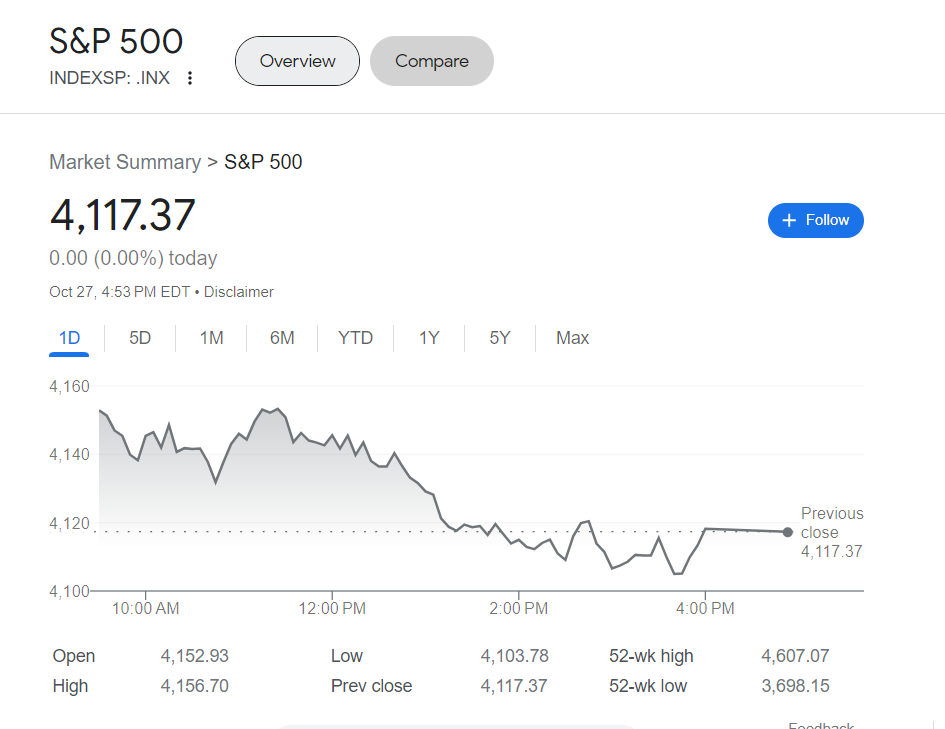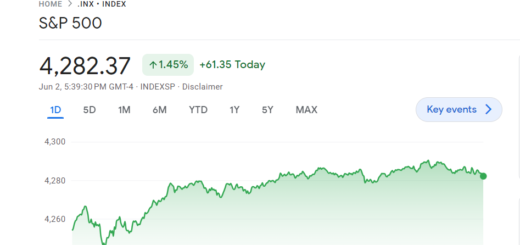Staying Strong Amid Market Turbulence: A Guide for Investors during S&P 500, Nasdaq Corrections
You have the option to evaluate specific stock prices, but a 5% profit on government-issued Treasurys is also advantageous.
Many people derive pleasure from experiencing a certain amount of fear.

The primary goal of Halloween has consistently been to serve as a precautionary measure, using eerie traditions to potentially reduce disorder if darker times are on the horizon.
Things become more complex when an individual’s fear begins to impact their savings, retirement savings, or investment portfolio. The fear of potential disorder has been particularly prominent in October, leading to a substantial decrease in the S&P 500 index. This decline caused the index to fall below 4,200, triggering a correction on Friday. Furthermore, the Nasdaq Composite Index also saw a decrease of at least 10% from its peak in the summer.
In addition, there has been a dramatic decrease in the value of bonds in the market, causing the yields of 10-year and 30-year Treasury bonds BX:TMUBMUSD10Y to rise significantly and come close to 5%. This sudden increase in yields can lead to increased borrowing costs for the American economy and potentially disrupt financial markets.
Rich Steinberg, who oversees $20 billion in assets as the chief market strategist at The Colony Group, emphasizes the importance of numbers. Steinberg points out that investors are currently faced with the challenge of identifying appropriate investment prospects and searching for secure places to allocate their funds.
According to Steinberg, when people are overwhelmed by fear, they may lose touch with reality. He proposes that investors can attain success by making around a 5.5% profit on shorter term Treasurys without any risk, and also by selecting stocks that match their desired price range.
He stated that this specific moment is where investors can genuinely take advantage in the future, as long as they possess enough resources to endure potential prolonged periods of instability.
As the Treasury Department prepares to reveal a borrowing need of roughly $1.5 trillion to address a sizable budget deficit, investors are growing increasingly worried about the spending habits of the U.S. government. If this occurs, it would introduce a large number of Treasury bonds into an already fragile market, potentially disrupting the operations of financial markets.
The rise in bond yields in the US presents a potential danger to the federal government’s ability to handle its debt, as well as causing difficulties for businesses through layoffs and a higher chance of loan defaults.
Fed decisions, yields
After their two-day meeting, the Federal Reserve is expected to keep its policy interest rates unchanged on Wednesday. This means that the rate will remain between 5.25% and 5.5%, which is the highest it has been in the past 22 years.
Typically, the true anticipation builds up for the afternoon press briefing conducted by Fed Chairman Jerome Powell following each decision on interest rates.
Bryce Doty, a senior manager of investment portfolios at Sit Investment Associates, is certain that the Federal Reserve will not increase interest rates during the current period. Doty believes that this will benefit bond funds in 2024, as the initial yields are presently higher compared to previous years.
On the contrary, Doty points out two possible factors that may cause instability in the markets. If there is a substantial rise in the amount of Treasury debt being released, it could lead to an overwhelming supply in the market. This, in turn, could result in higher yields and could potentially cause the Federal Reserve to restart its program of buying bonds.
Moreover, the conflict between Israel and Hamas has the possibility of intensifying, which could lead to a rise in worldwide armed conflicts. This, in turn, may cause a higher demand for reliable assets and consequently decrease bond yields in the United States.
In this situation, Doty suggests putting money into bonds that have a longer time frame, like BX:TMUBMUSD03M. This is because interest rates for longer periods of time are higher than rates for shorter periods, which leads to the Treasury yield curve becoming more steep. Doty believes that now is the perfect time for investors to keep extending their investment along the curve while it gets steeper.
Keith Lerner, currently serving as the chief markets strategist at Truist Advisory Services, expressed that the stock market has been facing significant challenges due to the issue of yields. He further noted that the volatility of stocks has persisted since the 10-year Treasury yield surpassed 4% in July.
Lerner pointed out that the “Magnificent Seven” stocks experienced a notable decrease of around 17%, but this decline is not as harsh as the drop observed in other areas of the S&P 500 index, such as real estate, which saw a retreat of about 20%.
He stated that we have had a satisfactory restart, and pointed out that lower stock prices are providing investors with slightly better compensation for the uncertainties ahead.
Cameron Brandt, the head of research at EPFR, remarked that the present investment climate is extremely challenging, drawing parallels to a time when difficulties were widespread. EPFR is tasked with overseeing the movement of funds among various asset classes.
Based on the circumstances, he expects that investors will keep more cash on hand until the end of this year compared to previous times.
Over the course of the week, the Dow Jones Industrial Average, or DJIA, went down by 2.1%, reaching its lowest level since the banking crisis in March. The S&P 500 saw a decline of 2.5% throughout the week, while the Nasdaq Composite fell by 2.6%.
Next week, there are a number of significant events scheduled, such as the announcement regarding Treasury borrowing and the Federal Reserve’s decision on Wednesday. Furthermore, the Labor Department will release the October jobs report on Friday.




